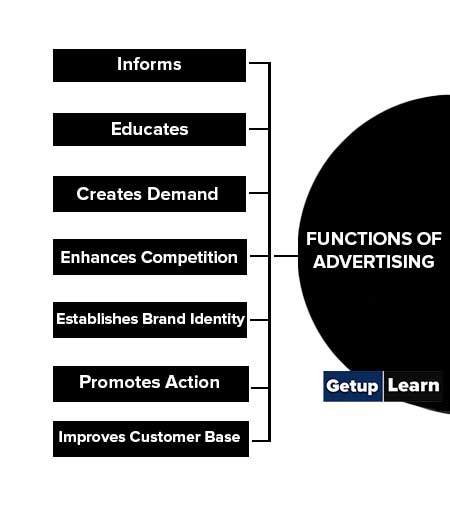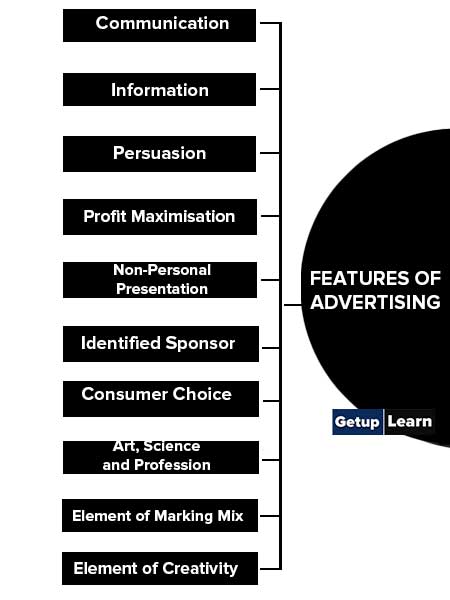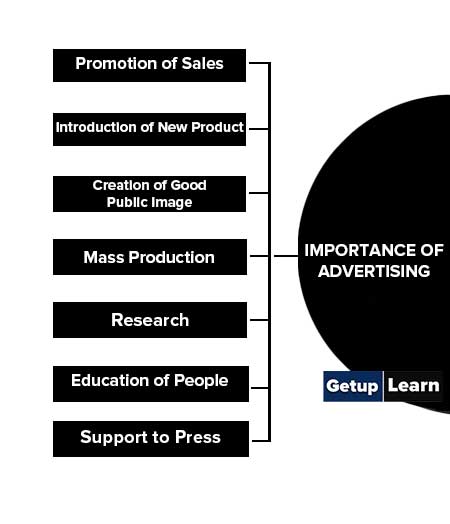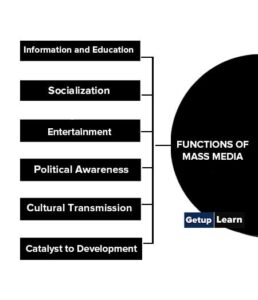Table of Contents
What is Advertising?
Advertising is a communication process that promotes a product, service, or event. According to American Marketing Association (AMA) advertising is “any paid form of non-personal presentation and promotion of goods, ideas or services by an identified sponsor”.

Advertising is said to be a paid form of communication because here an advertiser pays mass media like newspapers, radio, TV, internet for advertising space or time slots.
Definitions of Advertising
AMA defined advertising as any paid form of non-personal presentation of ideas, goods, and services by an identified sponsor
American Marketing Association
Advertising is to give public notice or to announce publicity.
According to Webstar
Advertising is the means of mass selling that has grown up parallel with and has been made necessary to mass production.
According to Gardner
Functions of Advertising
Advertising is a form of communication that deals with people’s feelings and emotions. It is shaped by the psychology of the buyer, especially in relation to his/her motives and attitudes.
The major aim of advertising is the promotion of a product, brand, or service. The major functions of advertising are that it:
- Informs
- Educates
- Creates Demand
- Enhances Competition
- Establishes Brand Identity
- Promotes Action
- Improves Customer Base

Informs
A product needs an effective launching to hit the minds of the consumers. It must share the details about the product’s quality, price, unique features, etc.
Consumers obtain information about products from the ads they have read, viewed, and heard. Manufacturers often make changes in prices, and channels of distribution, and improve the quality, size, weight, brand, and packing. These changes must be informed to the public through advertisements.
Eg: SBT’s print advertisement tells the consumers about a new deposit scheme. Here the ad shares information like the name of the deposit scheme, interest rate, benefits, etc.
Educates
Advertisements may carry messages intended for consumer education. They sometimes sell or popularise certain concepts. Government agencies educate the masses with campaigns on a variety of topics like consumer rights, safe driving, literacy, child rights, etc.
Advertising also educates consumers about the price, quality, and availability of a product. Eg: This social service ad advises the public not to consume alcohol while driving. It also cautions them about the after-effects of such an act.
Creates Demand
The main objective of advertising is to create demand for a product in the market. This demand would set a favorable climate and acceptability among potential buyers. Once the product is established, frequent advertising reminds the buyers about its presence in the market.
It may also induce new customers to notice the product. They may be convinced of the merits of the product through constant exposure to advertising. Eg. The advertising of Idea 3G connection with the cutline “No fooling India” creates demand for low-priced smartphones and third-generation networking.
Enhances Competition
Another important objective of the advertisement is to encourage competition. Advertising is unavoidable to compete with or neutralize competitors’ advertising. When competitors are adopting intensive advertising as their promotional strategy, it is reasonable to follow similar practices to neutralize their effects.
In such cases, the manufacturer tries to create a different image for his product.
Establishes Brand Identity
Developing a brand identity is one of the important functions of advertising. Through campaigns and striking messages, advertisers create an impressive image of the company in the minds of the audience. Such images make the audience loyal to the company or brand name.
Thus, brand loyalty helps to build emotional relationships between the audience and the products of such brands. This increases the chances of some consumers preferring a particular brand. Hence the advertising message finds success in winning the minds through brand identity.
Promotes Action
The purpose of advertising is to attract buyers through a call-to-action statement. This encourages the customer to visit a store or website, and to contact the advertiser for more information. Advertising is essentially an active catalyst.
The ultimate aim of advertising is to persuade an audience into action. The AIDA formula of advertising explains this concept.
- Attention: At first the advertising grabs the attention.
- Interest: Secondly the person becomes interested in the advertising message.
- Desire: The person is convinced of the claims and has a desire to purchase.
- Action: The desire leads the person to purchase the product.
Improves Customer Base
Any business requires a constant customer base in order to remain successful. The business needs to target its products and services to this customer base. The company creates new products that attract existing and new customers alike.
Advertising helps to reinforce the buying motives of customers for a particular brand. It establishes long-term relationships with customers, vendors, and stakeholders.
Powerful and captivating advertisements persuade consumers to purchase a new product, try out services, and fulfill voids they feel are present in their lives. In fact, persuasion is one of the main functions of advertising. So many firms strive to create powerful persuasive messages that influence customers emotionally and rationally.
Features of Advertising
These are some most important features of advertising given below:
- Communication
- Information
- Persuasion
- Profit Maximisation
- Non-Personal Presentation
- Identified Sponsor
- Consumer Choice
- Art, Science and Profession
- Element of Marking Mix
- Element of Creativity

Communication
Advertising is means of mass communication reaching the masses. It is a non-personal communication because it is addressed to the masses.
Information
Advertising informs the buyers about the benefits they would get when they purchase a particular product. However, the information given should be complete and true.
Persuasion
The advertiser expects to create a favorable attitude which will lead to favorable actions. Any advertising process attempts at converting prospects into customers. It is thus indirect salesmanship and essentially a persuasion technique.
Profit Maximisation
True advertising does not attempt at maximising profits by increasing the cost but by promoting the sales. This way It won‟t lead to an increase in the price of the product. Thus, it has a higher sales approach rather than the higher-cost approach.
Non-Personal Presentation
Salesmanship is personal selling whereas advertising is non-personal in character. Advertising is not meant for any one individual but for all. There is the absence of personal appeal in advertising.
Identified Sponsor
A sponsor may be an individual or a firm that pays for the advertisement. The name of a reputed company may increase sales or products. The product gets a good market because of its identity with the reputed corporate body.
Consumer Choice
Advertising facilitates consumer choice. It enables consumers to purchase goods as per their budget requirements and choice. The right choice makes consumers happy and satisfied.
Art, Science and Profession
Advertising is an art because it represents a field of creativity. Advertising is a science because it has a body of organized knowledge. The advertising profession is now treated as a profession with its professional bodies and code of conduct for members.
Element of Marking Mix
Advertising is an important element of the promotion mix. Advertising has proved to be of great utility to sell goods and services. Large manufacturers spend crores of rupees on advertising.
Element of Creativity
A good advertising campaign involves a lot of creativity and imagination. When the message of the advertiser matches the expectations of consumers, such creativity makes way for a successful campaign.
Objectives of Advertising
The fundamental purpose of advertising is to sell something – a product, a service or an idea.
In addition to this general objective, advertising is also used by modern business enterprises for certain specific objectives which are listed below:
- To introduce a new product by creating interest for it among prospective customers.
- To support the personal selling program. Advertising may be used to open customers’ doors for the salesman.
- To reach people inaccessible to the salesman.
- To enter a new market or attract a new group of customers.
- To light competition in the market and to increase sales as seen in the fierce competition between Coke and Pepsi.
- To enhance the goodwill of the enterprise by promising better quality products and services.
- To improve dealer relations. Advertising supports the dealers in selling the product. Dealers are attracted to a product that is advertised effectively.
- To warn the public against imitation of an enterprise’s products.
Importance of Advertising
Advertising has become an essential marketing activity in the modern era of large-scale production and serves competition in the market. It performs the following functions:
- Promotion of Sales
- Introduction of New Product
- Creation of Good Public Image
- Mass Production
- Research
- Education of People
- Support to Press

Promotion of Sales
It promotes the sale of goods and services by informing and persuading the people to buy them. A good advertising campaign helps in winning new customers both in the national as wet as in the international markets.
Introduction of New Product
It helps the introduction of new products in the market. A business enterprise can introduce itself and its product to the public through advertising. A new enterprise can’t make an impact on prospective customers without the help of advertising. Advertising enables quick publicity in the market.
Creation of Good Public Image
It builds up the reputation of the advertiser. Advertising enables a business firm to communicate its achievements in an effort to satisfy the customers’ needs. This increases the goodwill and reputation of the firm which is necessary to fight against the competition in the market.
Mass Production
Advertising facilitates large-scale production. Advertising encourages the production of goods on a large scale because the business firm knows that it will be able to sell on a large scale with the help of advertising. Mass production reduces the cost of production per unit by the economical use of various factors of production.
Research
Advertising stimulates research and development activities. Advertising has become a competitive marketing activity. Every firm tries to differentiate its product from the substitutes available in the market through advertising.
This compels every business firm to do more and more research to find new products and their new uses. If a firm does not engage in research and development activities, it will be out of the market in the near future.
Education of People
Advertising educates people about new products and their uses. Advertising message about the utility of a product enables people to widen their knowledge. It is advertising which has helped people in adopting new ways of life and giving up old habits.
It has contributed a lot towards the betterment of the standard of living of the society.
Support to Press
Advertising provides an important source of revenue for publishers and magazines. It enables them to increase the circulation of their publication by selling them at lower rates. People are also benefited because they get publications at cheaper rates. Advertising is also a source of revenue for TV networks.
For instance, Doordarshan and ZeeTV insert ads before, in between, and after various programs and earn millions of rupees through ads. Such income could be used for increasing the quality of programs and extending coverage.
Role of Advertising
Following are the basic role of advertising:
- Role of Advertising in Marketing Mix
- Role of Advertising in Society

Role of Advertising in Marketing Mix
The marketing mix consists of four important variables of marketing, i.e. 4Ps-Product, Price, Promotion, and Place. Apart from the traditional 4 Ps, there are also other variables, i.e. Packaging, Position, and Pace.
Advertising is an element of promotion. However, it not only assists in promoting the product but also affects the other variables of the marketing mix. This can be explained as follows:
- Advertising and Product
- Advertising and Price
- Advertising and Place
- Advertising and Promotion
- Advertising and Pace
- Advertising and Packaging
- Advertising and Positioning
Role of Advertising in Society
Advertising is an integral part of everyday life. It is a pervasive method of marketing in society. Though the methods by which marketers advertise have changed over the decades, the role and purpose of advertising have changed over the period of time.
Without advertising modern society cannot survive. Advertising is useful to society in the following ways:
- Encourage Purchasing
- Reflect Cultural Trends
- Promotes Economic Growth
- Improves Standard of Living
- Advertising and Brand Building
What are advertising and its purpose?
According to American Marketing Association (AMA) advertising is “any paid form of non-personal presentation and promotion of goods, ideas or services by an identified sponsor”. Advertising is purposes that promote a product, service, or event.
What is advertisement simple words?
Advertising is said to be a paid form of communication because here an advertiser pays mass media like newspapers, radio, TV, internet for advertising space or time slots.
What are the 7 functions of advertising?
7 Features of Advertising:
1. Informs
2. Educates
3. Creates Demand
4. Enhances Competition
5. Establishes Brand Identity
6. Promotes Action
7. Improves Customer Base.
What are the features of advertising?
These are some most important features of advertising given below:
1. Communication
2. Information
3. Persuasion
4. Profit Maximisation
5. Non-Personal Presentation
6. Identified Sponsor
7. Consumer Choice
8. Art, Science and Profession
9. Element of Marking Mix
10. Element of Creativity
What are the benefits or importance of advertising?
The benefits or importance of advertising are:
1. Promotion of Sales
2. Introduction of New Product
3. Creation of Good Public Image
4. Mass Production
5. Research
6. Education of People
7. Support to Press.















